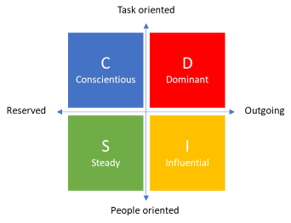If you are new to the idea of Team Praxis, please read our introduction to the concept before using the table below to improve your communications with team members, stakeholders and anyone else involved in your project, programme or portfolio.
 The goals of risk management are to:
The goals of risk management are to:
- ensure that levels of overall risk within a project, programme or portfolio are compatible with organisational objectives;
- ensure that individual risks and responses are identified;
- minimise the impact of threats to objectives;
- optimise opportunities within the scope of work.
When implementing these goals people with different character traits would perceive risk management plans and techniques in different ways.
 Concientious behaviour would typically propose or want to see: Concientious behaviour would typically propose or want to see:
-
a clear explanation of what risk management is aiming to achieve; -
a consistent and systematic approach to identifying, assessing and responding to risks; -
adequate information about risk that facilitates decision making; -
a focus on quantitative measures; communication and consideration of lessons learned from previous projects -
quantitative tools and techniques for assessing risks; -
inclusion of contingency; -
clear and comprehensive responsibilities agreed with each person. Someone exhibiting concientious behaviour would typically be perceived as: -
risk averse or risk neutral due to natural caution, the need for facts and detailed consideration and processing of risks; -
having a low risk appetite due to focus on compliance; -
supportive of methodical and proven techniques. |  Dominant behaviour would typically propose or want to see: Dominant behaviour would typically propose or want to see:
-
action taken quickly to minimise risk and maximise opportunity; -
assessment of resources to achieve this made in a dispassionate way, with a tangible demonstration of value; -
a focus on quantitative measures; -
tangible evidence of the benefit of risk management; -
a concise and efficient procedure that gives them freedom to take action as they believe necessary; -
a minimum amount of assessment necessary to allow decisions to be made and actions agreed; -
low levels of contingency together with a high level of monitoring and control; -
timely monitoring and control to ensure that people are being held to account. Someone exhibiting dominant behaviour would typically be perceived as: -
risk neutral or seeking as long as they have the freedom to take action as they see fit; -
having a high appetite for risk as long as the benefits are clear and they have freedom to act; -
dismissive of what they may perceive as unnecessary process; -
dismissive of behaviours that they perceive as hindering action and results. |
 Steady behaviour would typically propose or want to see: Steady behaviour would typically propose or want to see:
-
key individuals engaged in the procedure and given the opportunity to input; -
clearly identified roles for managing risk; -
a focus on qualitative measures in particular the impact of risk on people -
a cautious approach to risk; communication with people from previous projects to obtain lessons learned, focusing on the impact on people; -
the use of qualitative techniques for assessing risks; -
a high level of contingency to ensure that unforeseen risks can be dealt with; -
a clear process for monitoring of response actions. Someone exhibiting steady behaviour would typically be perceived as: -
risk averse and wishing to have clarity over the impact on them and those they have a relationship with; -
assessing probability and impact at a higher level than others; -
having a low appetite for risk as they are typically cautious in their outlook to life; -
keen to follow defined processes in full. |  Influential behaviour would typically propose or want to see: Influential behaviour would typically propose or want to see:
-
interaction within the team and with stakeholders as part of identifying risks; -
a clear message that risk management improves team effectiveness and efficiency; -
a focus on qualitative measures; -
a broad discussion of potential risks identifying more unusual risks; -
short term responsibilities for managing risks are identified; -
equal focus on opportunities and threats; -
a cautious approach being taken to the definition of risks; -
the definition of risks with a minimal level of formality or resources being deployed to achieve this; -
the adoption and use of qualitative techniques for assessing risks; -
low levels of contingency. Someone exhibiting influential behaviour would typically be perceived as: -
risk seeking and without the need for rigorous process or quantitative information around which decisions are made; -
assessing probability and impact in less detail than others; -
having a high appetite for risk due to a natural optimism. |
Thanks to Donnie MacNicol of Team Animation for providing this page.
 The goals of risk management are to:
The goals of risk management are to:
 Concientious behaviour would typically propose or want to see:
Concientious behaviour would typically propose or want to see: Dominant behaviour would typically propose or want to see:
Dominant behaviour would typically propose or want to see: Steady behaviour would typically propose or want to see:
Steady behaviour would typically propose or want to see: Influential behaviour would typically propose or want to see:
Influential behaviour would typically propose or want to see:



